
* The Dash-80 demonstrator led not only to the 707 jetliner, but also to the KC-135 tanker. The KC-135 tanker would prove long-lived, and be given major updates to keep them in service. A relatively small number "C-135" interim transports were also produced, with a few of them lingering in service for decades. In addition, another small number of KC-135s would be used as testbeds, with these machines having a great diversity of configuration.
* As discussed earlier, Boeing's interest in replacing the KC-97 Stratotanker with a jet-powered successor led in 1954 to the flight of the Dash 80 demonstrator, with Boeing envisioning it as the basis for both a tanker and a jetliner. The Dash 80 had a fuselage width of 3.35 meters (132 inches), accommodating 4-four across seating; the Dash 80 was then redesigned with a fuselage width of 3.366 meters (144 inches), for five-across seating; and then redesigned again to a fuselage width of 3.76 meters (148 inches), for six-across seating. The six-across design became the 707 jetliner, but the five-across design wasn't a dead end.
Also in 1954, the USAF Strategic Air Command held a competition for a jet tanker; the Lockheed Company won with their "L-193" design, but since it wasn't flying at the time, the Air Force ordered an initial batch of 29 Boeing "Model 717" tankers as an interim solution, with these machines to be given the service designation of "KC-135". In reality, the L-193 never would fly, while the KC-135 would soldier on handily into the next century. Initial flight of the first KC-135, named CITY OF RENTON, was on 31 August 1956, with first production delivery to Castle Air Force Base, California, in June 1957.
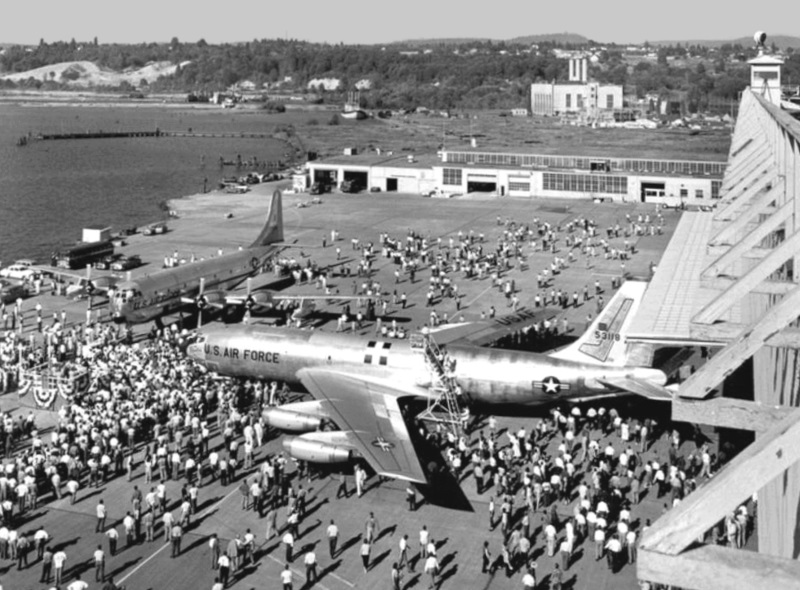
The baseline KC-135A was very similar in appearance to the 707, being a sleek all-metal aircraft with a low wing, swept back by 35 degrees, and four turbojet engines. The wings were generally like those of the 707, with a two-section leading-edge Krueger flaps on the front of the wing; while the rear of the wing featured an inboard flap, a small inboard high-speed aileron, an outboard flap, and an outboard aileron -- plus two spoilers on top of the wing. Tail surfaces were swept, with all flight control surfaces manually actuated. The nose gear, like the 707, had twin wheels, while each main gear had four wheels.
The KC-135A was powered by PW J57-P-59W turbojet engines, each generating 44 kN (4,535 kgp / 10,000 lbf) dry thrust each, and about 58 kN (5,895 kgp / 13,000 lbf) wet thrust. Engine starting was by ground air cart, or pyrotechnic cartridge -- cartridge starting being a specific difference between the J57 and its JT3 civil equivalent, since airlines did not use cartridge starting as a rule. There were no turbocompressor humps on any of the engines -- though they would be fitted, in an irregular pattern, on some descendant variants of the KC-135. When installed, the turbocompressors were typically, possibly always, installed on three of the four engines.
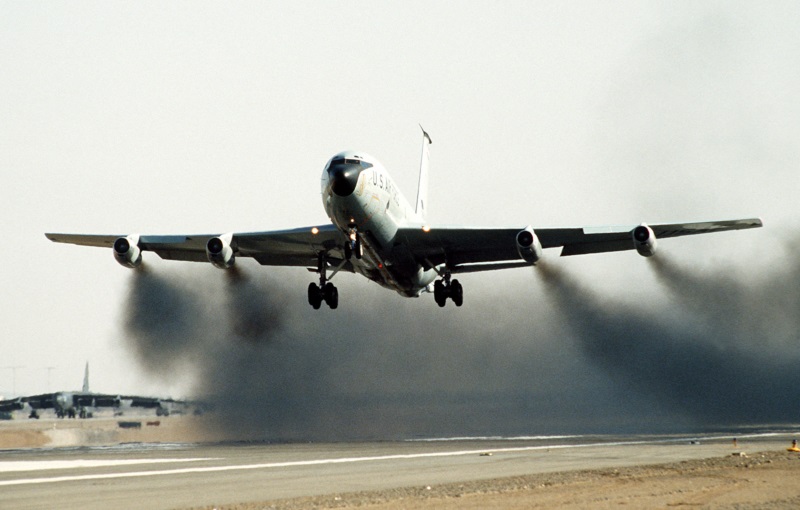
There was a crew door into the cockpit in the lower left forward fuselage; a large upward-hinged cargo door ahead of the left wing; an emergency exit door above the left wing; a matching door on the right fuselage, plus a door behind the wing. Incidentally, the Dash 80 demonstrator had featured fore and aft upward-hinged cargo doors.
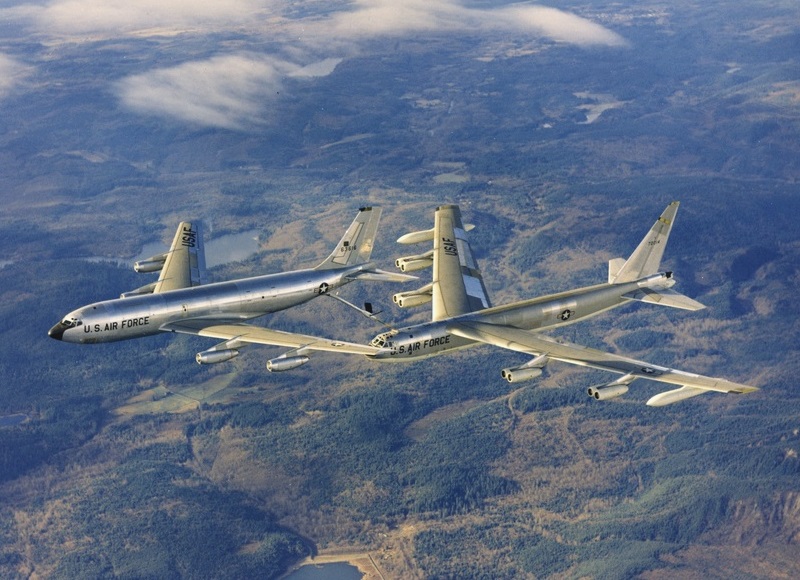
The KC-135 was, of course, generously equipped with fuel tanks:
Maximum fuel load on the KC-135A was 113,700 liters (30,000 US gallons); since there was tank capacity for a bit more, that may have been a load limit. The fuel load limit was of course reduced if the KC-135A was carrying passengers or cargo. The KC-135A used single-point refueling, with the connection in the right main landing gear well. All the fuel could be used either to power the aircraft or offload to a receiver aircraft, except for the fuel in the reserve tanks. The tanker boom assembly was derived from that of the KC-97 and trialed on the Dash 80; later KC-135A production had a boom with improved streamlining, with earlier machines presumably updated to the revised boom configuration.
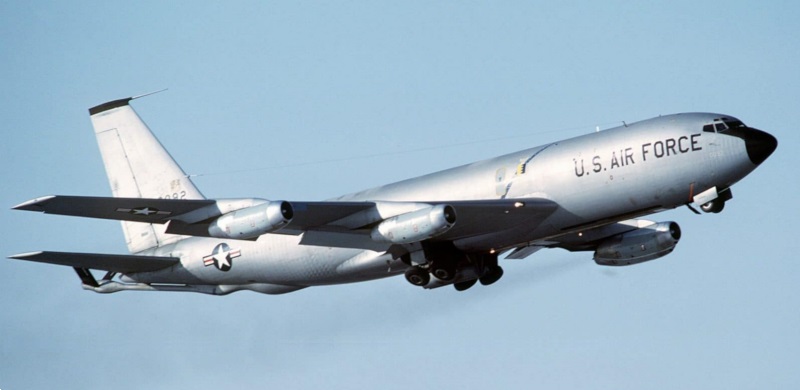
Normal crew was pilot, co-pilot, navigator, and boom operator; there was also a cockpit jump seat for an observer. The boom operator laid prone in a rear compartment, observing a receiving aircraft through a set of windows, and "flying" the boom with a sidestick controller, the boom being guided by vee wings. There were dual rows of director lights on the lower fuselage to guide the pilot of a receiver aircraft; floodlights were eventually added to support the refueling system. An adapter kit was developed to permit the flying boom to be used with hose-drogue refueling. Incidentally, the KC-135 refueling drogue or "basket" was made of metal, and apparently tended to intimidate pilots trying to hook up with it; it became known as the "wrecking ball".
There were 80 tip-up passenger seats, lining the cargo bay walls; 80 more seats could be installed in the center of the cargo bay, for a total of 160 seats. The cargo bay could also be kitted up with litters for medical evacuation. All crew and passenger spaces were pressurized. A cargo loader system was developed that stuck out the cargo door, allowing loads to be winched up and then moved around inside, with twin hoists on rails. The cargo loader system cut into cargo space, however, and more often external gear, such as fork lifts, were used to load and unload cargoes.
A total of 732 KC-135As was built in all, the last being delivered in 1965. After initial production, a set of reinforcing bands was applied to the rear fuselage to eliminate airframe resonance. The first 582 machines had a short tailfin, later production had a tall tailfin. Earlier machines were updated with these improvements.
Along with the KC-135As, in the late 1970s four RC-135A photo-survey machines -- discussed later -- were converted into a tanker configuration like that of the KC-135A in the early 1970s, and designated "KC-135D". In roughly the same time period, a grab-bag of nine special-mission EC-135 and RC-135 machines was converted to a KC-135 configuration. All these machines were configured as "aerial refueling receivers", meaning they had a socket for inflight refueling (IFR), and were appropriately designated "KC-135 (ARR)", later "KC-135RT". One was used as a trainer.
* The French obtained 12 new-build KC-135As in 1964, originally under the designation of "C-135F" -- the designation acknowledging that they were at least as much intended for the cargo as the tanker role. They had reinforced floors for hauling cargo; they could handle 102 passengers, or 40 medical litters.

The tankers were obtained because during the 1950s, the French worked on developing an independent nuclear strike force -- a notion that did not go over well in the Eisenhower White House. The French were developing the Dassault Mirage IV supersonic jet bomber as a delivery platform -- but it was short on range, and so France needed tankers to allow the Mirage IV to reach targets behind the Iron Curtain. The Kennedy White House had misgivings over the idea as well, but finally accepted the French position.
In a peculiar exercise, the Kennedy Administration publicly denounced the French nuclear program, while quietly approving the sale of the tankers in June 1962 to maintain a good, if argumentative, relationship with France. They were the last KC-135 tankers built. Since the French didn't have any aircraft that used boom refueling, the C-135Fs always flew with a drogue adapter -- at least until later in their lives.
BACK_TO_TOP* The KC-135A tankers were serially updated to improved variants. The first update was the "KC-135Q", which was a KC-135A modified to support the Lockheed A-12 / SR-71 Blackbird Mach-3 spyplane. The SR-71 required nonvolatile JP-7 fuel, optimized for high-altitude flight, as opposed to conventional JP-4 fuel. All the fuselage tanks were used to store JP-7; there were two refueling points, one in the right main gear well to pump JP-7 into the body tanks, the other in the left main gear well to pump JP-4 into the wing tanks.
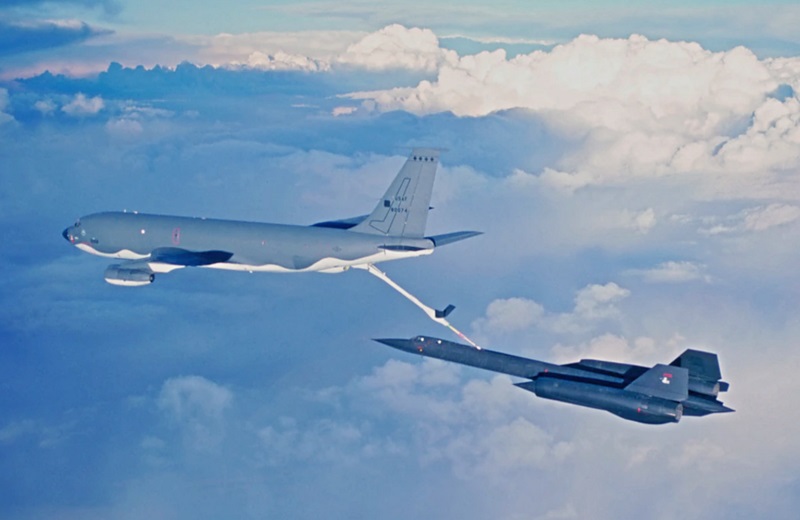
The KC-135Q also had additional communications gear and other avionics to support the SR-71. Some KC-135Qs didn't have the additional avionics, though it could be installed if desired; these machines were called "Partial Qs". There were 21 Q-conversions originally, eventually up to a total of 56, with refueling operations from 1962. If the body tanks were cleaned out by being air-flushed, they could be and often were loaded with JP-4 instead, to be used for conventional air-tanker missions. Incidentally, nobody's quite sure today why the out-of-sequence "Q" suffix was used.
* In the late 1970s, work began on a major upgrade of the KC-135 fleet, the centerpiece being the "CFM56-2B1" turbofan, military designation "F108-CF-100", with 97.9 kN (9,975 kgp / 22,000 lbf) thrust each. This was less thrust than provided by CFM56 variants used on some military 707s, possibly because those were later variants; while the CFM56 became most closely identified with the 737 jetliner, the KC-135 was the first operational aircraft to be fitted with it. However, the increased power still meant a substantial increase in fuel load, well over 50%; the engines were also more fuel-efficient, quieter, and more reliable than the J57s, with an electronic engine monitoring system. The first "KC-135R" performed its initial flight in 1982, with conversions then ramping up.
___________________________________________________________________
BOEING KC-135R:
___________________________________________________________________
wingspan:
39.88 meters (130 feet 10 inches)
wing area:
226 sq_meters (2,433 sq_feet)
length:
41.53 meters (136 feet 3 inches)
height:
12.7 meters (41 feet 8 inches)
empty weight:
48,220 kilograms (106,305 pounds)
MTO weight:
146,285 kilograms (322,500 pounds)
max speed:
980 KPH (610 MPH / 530 KT)
cruise speed:
855 KPH (530 MPH / 460 KT)
service ceiling:
12,715 meters (41,720 feet)
operational radius:
4,625 kilometers (2,875 MI / 2,500 NMI)
___________________________________________________________________
The KC-135Rs were given a range of updates along with the new engines, including:
The CFM56 upgrades would continue in installments over a quarter of a century. The KC-135A (ARR) machines, with the ability to be refueled in flight themselves, of course became "KC-135R (ARR)" -- later "KC-135R (RT)" -- machines after being updated with the CFM56 engines. The KC-135Q tankers, after being updated from 1993, became "KC-135T" tankers; it appears there were 54 updates, included in the total of 417. By that time the SR-71 had been retired, but there were other aircraft, like the Lockheed U-2, that demanded special fuel, and the KC-135Ts could be used to refuel ordinary aircraft anyway. A few special-mission machines were also updated.
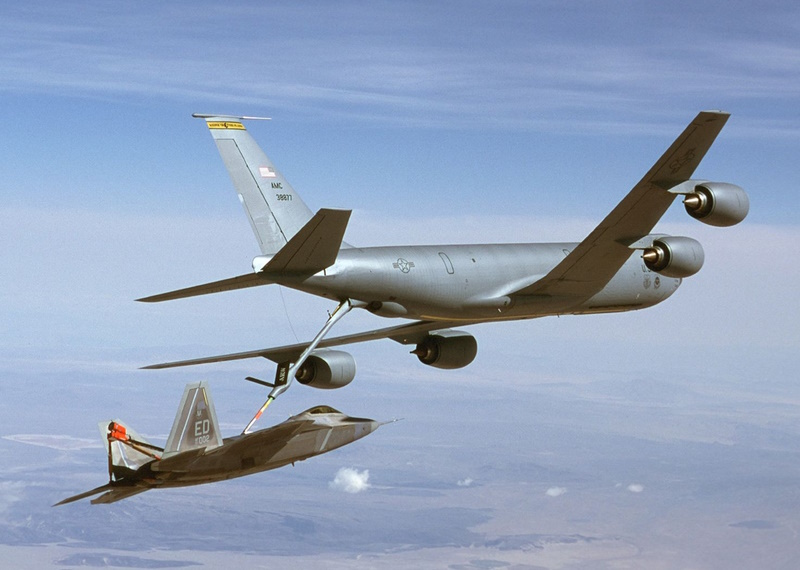
All 11 surviving French C-135F tankers were updated with CFM56 engines from 1985 -- ironically, the one that was lost was due to a mishap with the J57 water-injection system, so the French were eager to update. The updated machines were redesignated "C-135FR". From 1986, they were given blue-gray camouflage colors, the paint scheme being based on that of the Dassault Mirage F1 in French service, to become the first camouflaged KC-135s. In 1994, the French also obtained three ex-USAF KC-135As that were upgraded to C-135FR standard before delivery, these machines being designated "KC-135RG".
The USAF only wanted to update active-duty KC-135s to the CFM56 turbofans, but also didn't want to short-change the Air National Guard (ANG) or the Air Force Reserve (AFRES). As a result, a program was initiated in parallel to update ANG/AFRES KC-135s to TF33-PW-102 (JT3D) turbofans, obtained from Boeing 707 airliners bought used by the Air Force, with the renewed machines being redesignated "KC-135E". These updates had the three turbocompressors, providing a useful recognition feature.
The TF33, while not at all in a league with the CFM56, was nonetheless more powerful, more fuel-efficient, quieter, and cleaner than the J57. Unlike the J57, the TF33 had thrust reversers. The first update was re-delivered in 1982, with at least 161 updated -- it appears including a number of special-mission types. Roughly in parallel with the engine updates, the Air Force had the wings of the fleet reskinned, including the special-mission variants. The last TF33 upgrade was redelivered in 2002.
Incidentally, although no KC-135Qs were updated to TF33s -- instead going straight to CFM56s to become KC-135Ts -- there was at least one KC-135E that could refuel SR-71s. This machine ended up, for at least of its career, being flown by the US National Aeronautics & Space Administration (NASA) as an "NKC-135E" trials machine, and doing tanker duty for SR-71s loaned to NASA. The trials machines are discussed in detail later.

* The re-engined KC-135s have undergone further upgrades. From 1999 to 2002, the KC-135 fleet -- including the special-mission types -- were given a cockpit upgrade under the "Block 30" AKA "Pacer CRAG (Compass, Radar, And GPS)" program, which involved adding:
The GPS and TCAS were a first step towards a "Block 40" or "Global Air Traffic Management (GATM)" upgrade -- later changed to the more verbose title of "Communications, Navigation, & Surveillance for Air Traffic Management (CNS/ATM)" upgrade -- to allow the fleet to operate in modern civil airspace. It featured an updated GPS navigation system, commercial satellite communications (satcom) link, a dual datalink radio system, and two processors. The updates were performed from 2003 to 2011. The French also updated their three ex-USAF KC-135RGs with GATM, but not the older C-135FRs.
Roughly in parallel with Pacer CRAG, a total of 45 KC-135Rs were fitted with the "Multi-Point Refueling Systems (MPRS)", being able to carry a Flight Refueling Mark 32B hose-drogue refueling pod under each wing. In the early 1990s, the French also obtained a set of refueling pods; they had acquired the Boeing E-3 Sentry Airborne Warning & Control System, based on the 707, which had boom refueling capability, and need to support both boom and drogue refueling. All 11 C-135FRs were modified for the pods, but not the KC-135RGs.

* The last KC-135R was redelivered in 2005. 420 KC-135A and KC-135E machines were updated for the USAF, plus 25 special-mission platforms. Along with the 14 French updates:
The last KC-135Es were retired from the US Air Force in 2009, leaving only CFM-powered machines in operation with the service and with foreign users -- except for Chile, which obtained three of the KC-135Es in best condition in 2010.
From 2006, 40 KC-135s were modified to carry the "Roll-On Beyond Line Of Sight Enhancement (ROBE)" system, which relayed datalink communications via the NATO-standard "Link 16" system and the "Situational Awareness Datalink (SADL)". It consisted of a set of antennas and other support kit added to the KC-135 airframe, plus a set of boxes that were installed on an aircraft as needed. 20 ROBE kits were obtained, with the system seeing action in Afghanistan. The tankers were not assigned the relay mission; they were still operating as tankers, but performed datalink relay while they were doing it.
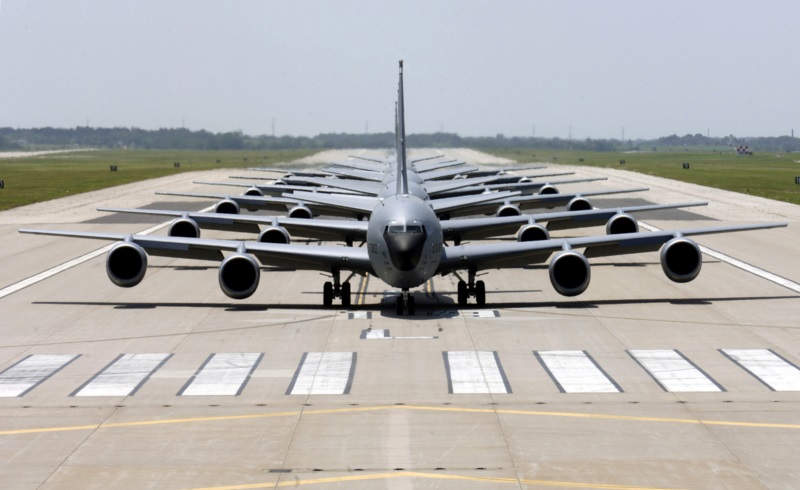
From 2013, the KC-135Rs -- and other US military aircraft using the CFM56 engine -- received an engine update under the "CFM Propulsion Upgrade Program (C-PUP)" to reduce maintenance, extend engine life, and improve fuel efficiency. That was followed by the "Block 45" upgrade, which was re-delivered from 2017. The update got rid of the old analog flight deck, replacing it with a modern glass cockpit, plus a radio altimeter, digital autopilot, and flight computer. The Block 45 update was followed in turn by fit of an ADS-B transmitter.
From 2018, there has been work on a "Real-Time Information in the Cockpit (RTIC)" effort to update the KC-135, using a "Gladiator" pod in place of a hose-drogue tanker pod. The Gladiator pod supports, or eventually will support, Link-16, SADL, and the "Secure Beyond Line-of-Sight" (satellite) communications link. It seems RTIC is part of a "smarter" system than ROBE, featuring "data fusion" capabilities to sum inputs from systems on the datalink network. In one demonstration, a KC-135 crew controlled a Kratos "loyal wingman" combat drone, suggesting the potential of a KC-135 directly controlling airstrikes -- or for that matter, using loyal wingman drones for self-defense.
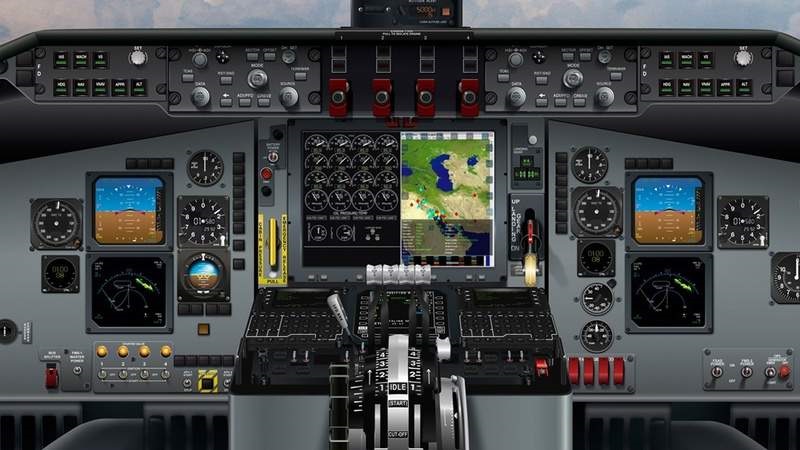
RTIC is expected to help bring up the Pentagon's "Advanced Battle Management System (ABMS)" -- a digital combat networking system that will collect, process, and share data among US and allied forces in real time. It is not clear if the RTIC effort will lead to new mission taskings for the KC-135 or if, like ROBE, the idea is that the KC-135 will incidentally support secondary missions, with smaller dedicated platforms becoming central nodes in ABMS.
Work is currently in progress on modifying a stock KC-135R for uncrewed operation. The technology is being developed by a US company named "Merlin", working with Sierra Nevada Corporation -- which specializes in aircraft modification. Schedule is unclear. The USAF would like to reduce the number of crews needed to support the still-extensive KC-135R fleet, and pave the way for an optionally-crewed future tanker fleet.
Singapore retired its KC-135Rs in 2019, the type being replaced by the Airbus A330 Multi-Role Tanker-Transport (MRTT). All four were sold to Omega Air Refueling, a "flight services for hire" company. France got rid of its KC-135Rs in 2019, these machines being replaced by six A330 MRTTs. Although the KC-135R is being replaced in USAF service by the KC-46, a modified Boeing 767, it will keep flying for the Air Force to at least 2030 or even 2040, the KC-46 program having had long delays.
BACK_TO_TOP* At the beginning of the 1960s, the USAF was still dependent on prop aircraft, such as the lumbering Douglas C-124 Globemaster, for long-range air transport -- which was something of an embarrassment, given that jets were becoming the norm of commercial aviation. The Air Force planned to obtain the Lockheed C-141 Starlifter for the cargo-transport role, but it wouldn't be available quickly -- and so, in 1960, the USAF ordered 50 "C-135A" dedicated transport machines.
They were to have minimum changes from the KC-135A itself; there was talk of giving them a "swing tail" to permit more convenient cargo loading, but it didn't happen. They didn't even have rows of passenger windows. They retained the tanker-boom bump under the lower rear fuselage, but it was only connected to a fixed-position fuel-dump pipe. The only other major difference from the KC-135A was that the C-135A had a reinforced floor. Despite the order for 50 C-135As, only 15 were built new, with three more converted from KC-135As. 20 further "C-135B" machines were built new, featuring TF33 turbofans instead of the J57 turbojets.
The C-135 was strictly an interim solution. It didn't handle large cargoes conveniently, it didn't have an airdrop capability, and it required long prepared runways -- meaning troops would often have to be dropped off well away from where they were to be deployed. There were no other dedicated KC-135 transport variants. The C-135 was retired from the transport role from 1966, as the C-141 came into service. Of course, they were still perfectly good aircraft and they were adapted to other roles, as detailed later.
In addition, also as detailed later, three WC-135 weather reconnaissance machines were modified to VIP transport configuration, and designated "C-135C". It appears a few KC-135Es were also converted to VIP transports, though they did not officially become "C-135E" machines. The most famous of the C-135Es was the "Speckled Trout" -- after a program coordinator named Faye Trout, who was freckled. The Speckled Trout was used from 1974 as a USAF senior brass VIP transport, being painted in natty white colors. It was also used for test and trials.

The Speckled Trout was retired in 2006, being replaced in 2008 by a KC-135RT, with a more conventional paint scheme. Although it appears it was configured as a passenger transport, by the time it went into service, the USAF was settling on the C-37 (Gulfstream bizjet) and C-40 (Boeing 737) for the VIP transport role, and the new Speckled Trout ended up as a trials machine.
BACK_TO_TOP* The KC-135 was in fact used as a test and trials platform from early on. Indeed the first KC-135, CITY OF RENTON, was handed back to Boeing after USAF evaluation, to be used for test and development. Other KC-135s followed in the test and trials role, sometimes without a designation change, or under the general designations of "JKC-135" and "NKC-135" -- or "JC-135 / NC-135" if they were derived from a C-135 transport. The "J" prefix indicated a temporary modification, while the "N" prefix indicated a full-time test aircraft; the "N" prefix eventually dominated. Photos suggest that KC-135As flying as trials machines were rarely updated to TF33 engines.
The KC-135 was well suited to test and trials because of its lift capacity and its good performance in terms of speed, ceiling, and range. It also had considerable electrical power generation capability, important for operating test and trials kit. The testbeds were often flown out of Wright-Patterson AFB in Ohio and later Edwards AFB in California, though they were flown out of other sites as well -- such as Rome AFB in New York state, where the Air Force has a technical development center.
Any one KC-135 flown as a testbed might have supported a series of different trials, with at least 16 KC-135s set aside by the Air Force as full-time test and trials machines. Gear evaluated by the testbed KC-135s included advanced cockpit decks, radio or IFF systems, laser communications systems, radars, navigation systems, and jammers; they also monitored tests of cruise missiles, and performed high-altitude atmospheric and astronomical observations. They featured a wide array of modifications, including antennas, antenna fairings, additional windows, observation domes, and so on.
Some of the testbed KC-135s were effectively prototypes for operational systems, indeed were often updated to operational machines; these testbeds are discussed later. Others were essentially minor modifications of one or two aircraft for special missions, but were still designated as trials aircraft -- the USAF "Big Safari" office often performed such conversions.
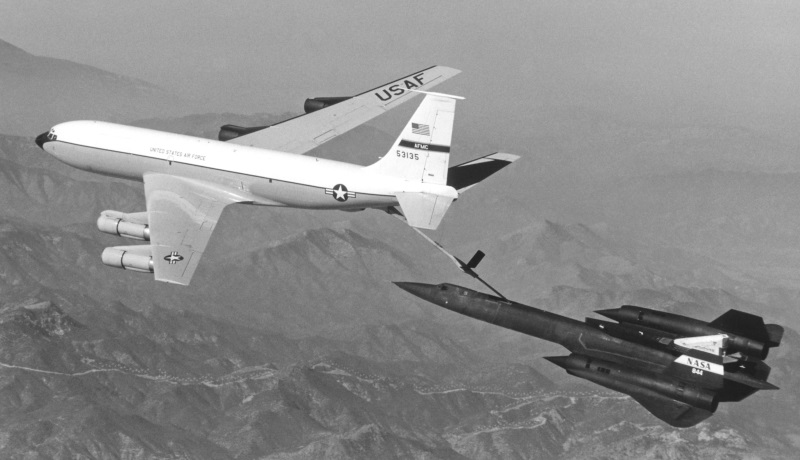
Significant testbed KC-135s included, this not remotely being a complete list:
There were also the "Big Crow" NKC-135As that were flown by the USAF as electronic warfare (EW) systems evaluation aircraft -- but they were semi-operational machines as well, being used in training exercises for all US combat services, and sometimes US allies; they were even flown in combat operations in a pinch.
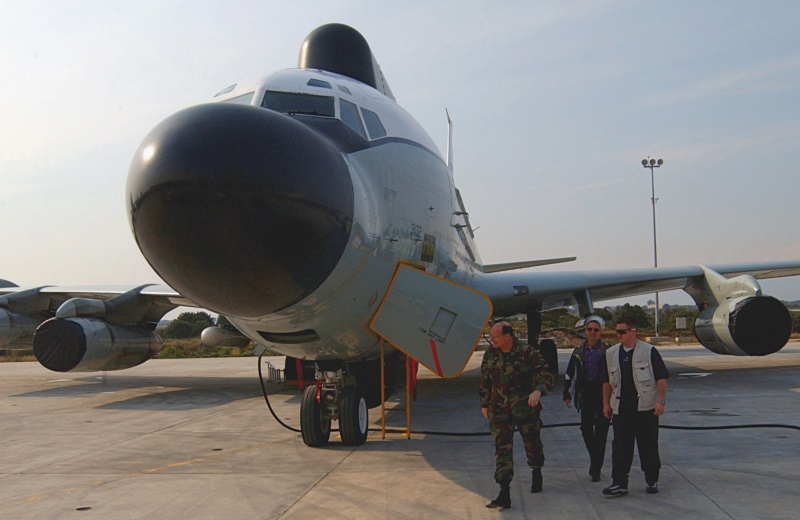
Apparently they varied in configuration over time, but the definitive Big Crow configuration featured canoe fairings top and bottom on the forward fuselage, and bulbous nose; they also had a tail fairing at one time. They were fitted with chaff-flare dispensers, and could carry jammer pods on underwing pylons, inboard of the engines. They were updated to TF33s.

There were also two comparable, if by their looks less sophisticated, "Navy King Crow" NKC-135A machines, used by the US Navy for training exercises. It appears that use of the KC-135 for trials declined during the 1990s, and it is not much used in such roles today.
BACK_TO_TOP